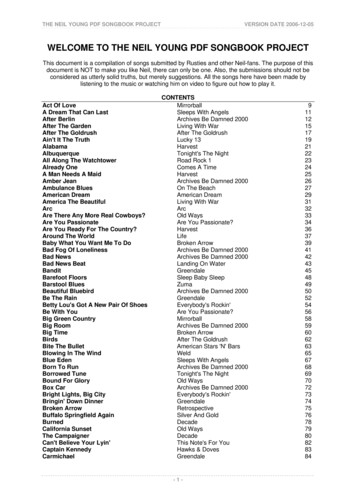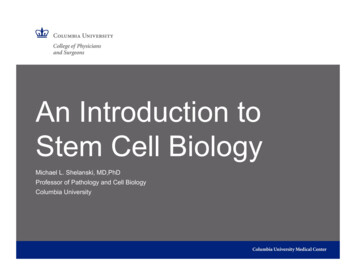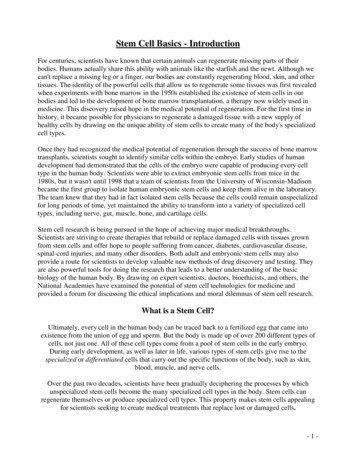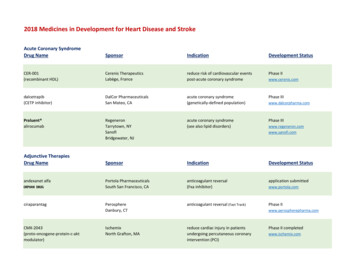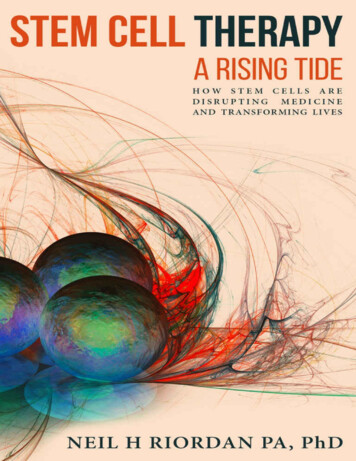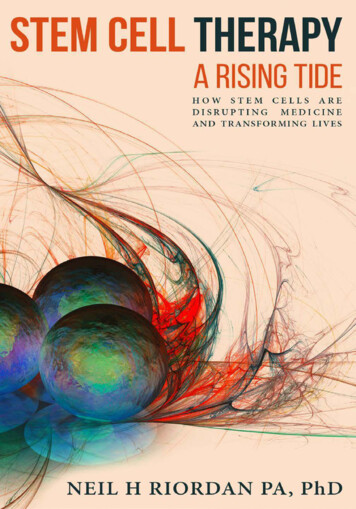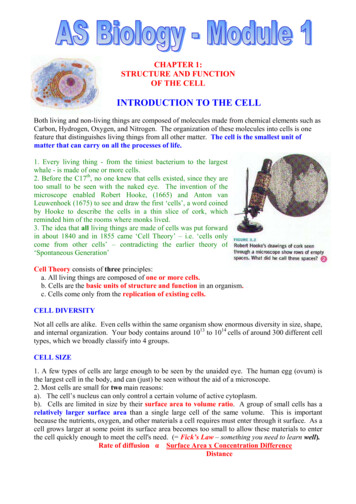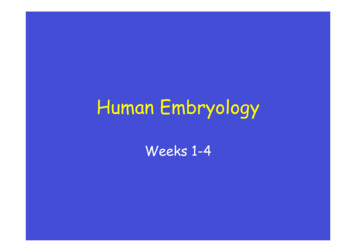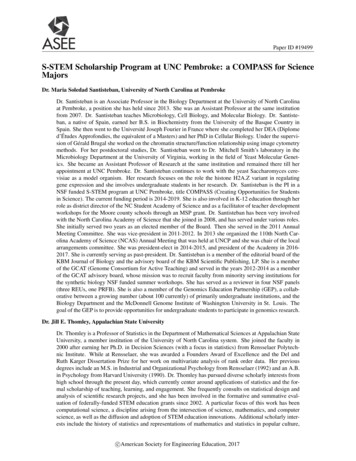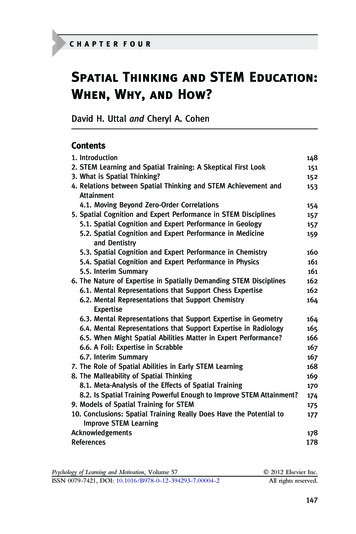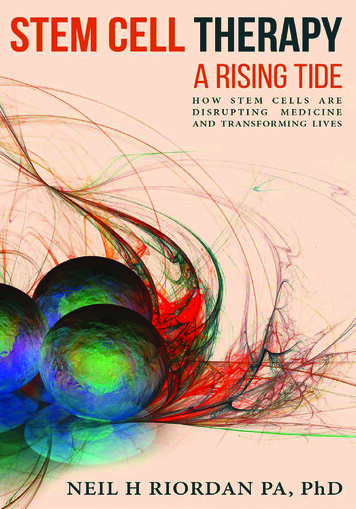
Transcription
Stem Cell TherapyA Rising T ideHow Stem Cells areDisrupting Medicine andTransforming LivesNeil H. Riordan
Stem Cell Therapy: A Rising TideHow Stem Cells are Disrupting Medicine and Transforming LivesCopyright 2017 by Neil Riordan, PA, PhDAll rights .comNo part of this book may be used or reproduced in any manner whatsoever withoutwritten permission from Neil Riordan, except as provided by the United States of Americacopyright law or in the case of brief quotations embodied in articles and reviews.This book is not intended as a substitute for the medical advice of physicians. Theinformation provided in this book is designed solely to provide helpful information on thesubjects discussed. The reader should regularly consult a physician in matters relating totheir health and particularly with respect to any symptoms that may require diagnosis ormedical attention. While all the stories in this book are true, some names and identifyingdetails have been changed to protect the privacy of the people involved.Layout design by www.iPublicidades.comIllustrations byBlake Swanson – Innercyte: Medical Art StudiosSteve Lewis – Blausen MedicalStem Cell Institute & Riordan-McKenna InstituteCovert design by n23artPrinted in the United States of America.First Printing: 2017ISBN: 978-0-9990453-0-5
TABLE OF CONTENTSForeword . vIntroduction . viiCHAPTER ONE: The Seed Is Planted—Hope for MuscularDystrophy . 1CHAPTER TWO: The Body’s Innate Healing Ability—Cancer Spelled Backwards . 11CHAPTER THREE: Redirecting the Immune System—Cancer Exposed . 21CHAPTER FOUR: Getting Started with Stem Cells . 31CHAPTER FIVE: Stem Cells in Action . 45Arnold Caplan Interview .49Robert Harari Interview .67CHAPTER SIX: Spinal Cord Injury—The Ultimate Repair . 77CHAPTER SEVEN: Multiple Sclerosis—Calming the Immune System . 91Bob Harman Interview .98CHAPTER EIGHT: Heart Failure Turnarounds—A New Approach . 113— iii —
Stem Cell Therapy: A Rising TideCHAPTER NINE: Frailty of Aging—Reversing the Inevitable . 125CHAPTER TEN: Respiratory Disorders—A Fresh Breath . 141CHAPTER ELEVEN: Arthritis—A New Solution . 149CHAPTER TWELVE: Biologics in Orthopedics—The Riordan McKenna Institute . 163CHAPTER THIRTEEN: Autism—Progress, Not Regression . 185CHAPTER FOURTEEN: Ulcerative Colitis—Autoimmunity in the Gut . 201CHAPTER FIFTEEN: Diabetes—A Paradigm Shift . 205CHAPTER SIXTEEN: Lupus—An Opportunity inAutoimmune Health . 211CHAPTER SEVENTEEN: Magic Juice—The Elixir of Life? . 215CHAPTER EIGHTEEN: Lifestyle Choices—How to Protect Your Health . 221CHAPTER NINETEEN: Controversy and Legality . 231Conclusion . 243Epilogue . 249References . 255Acknowledgments . 287— iv —
ForewordAs I read this book, I became very emotional. I had to go back about 28 yearsago when my wife and I sat in a doctor’s office and listened to a neurologistlist in grim detail how our beautiful three-year-old son Ryan would spendhis next 20 years. The doctor told us there was nothing that they could do atthat time. He suggested that we do everything we could to keep Ryan activein order to maintain the strength he had as long as possible. And hopefullyin the next 20 years they might find a cure for muscular dystrophy. Theprognosis changed our lives forever. It was a very painful time for all of us.As I continued to read about all of the patients who have been treatedby Dr. Riordan, I realized that we all had one thing in common: traditionalmedicine had given up on us. There was nothing that could be done. Ourown government, founded on the premise of life, liberty, and the pursuit ofhappiness, had evolved into overreaching bureaucracy that would attempt toprevent us from seeking lifesaving alternative treatments.But once again, we all had something else in common. We found a manwho was willing to do everything in his power to offer us options and give ushope for the future of our loved ones. Dr. Riordan has truly dedicated himselfto his profession as a medical pioneer. He has sacrificed everything he hasto give those who have been told there are no options a fighting chance andreal hope for the future.— v —
Stem Cell Therapy: A Rising TideDr. Riordan has never wavered in the face of scrutiny. It takes true courageto stand up to the often judgmental “traditional” medical community—thosewho act offended when you suggest that there might be a different way.Fortunately for all of us, Dr. Riordan had the foresight to look beyondthe walls of traditional medicine and fight the fight for us. I encourage youto read this book, and not just the chapters related to your condition. As awhole, the book lays out Dr. Riordan’s courageous and successful journeythrough his stories and the stories of his patients.Thank you, Dr. Riordan, for all that you have done for us and our families.You truly are a hero!George Benton, Ryan’s father— vi —
IntroductionBY ARNOLD CAPLAN, PHDNeil Riordan, PhD, PA is a pioneer of the highest order, in some ways likeJohn Glenn or Neil Armstrong. Neil has ventured where the routes wereuncharted and the dangers huge. His rocket of cell therapy was launchedon a rickety platform filled with hopes and dreams, and powered by anengine of money. This pioneer has hacked his way through the jungle ofnaysayers and has produced miracles of enormous proportions. He hastaken our scientific dreams and translated them into a high-caliber medicalfacility that does good by offering exposure to cell therapy treatments thatwe working scientists only dream about.Although there are those in my professional realm who would say thatNeil is a medical “cowboy” who “experiments” with human subjects, I wouldsay that he is providing access to therapies that are no more experimentalthan one sees every single day in the surgical suites of major medicalcenters. In such situations, the surgeon is “forced” to improvise because ofthe complexity of the wound field. Such improvisation sometimes involvesusing materials that are not approved but that the surgeon “feels” will workwell in the situation he faces. For example, human decellularized skin fromdead people was approved for topical applications for ulcerated wounds indiabetic patients. But these “membranes” are fabulous for closing abdominalsurgical wounds in hernia repair operations and have changed the way suchclosures are done. This surgical improvision, originally performed by a“cowboy” surgeon, is now the standard of care. We move forward in medicineby the skill and insightful work of pioneers—some with IRB approval andsome not. Riordan’s procedures with MSCs currently have IRB approvals.— vii —
Stem Cell Therapy: A Rising TideIn a sense of transparency, let me say that I have accepted honorariafrom Neil Riordan and gifts of hotel rooms, meals, and, indeed, infusionsof MSCs. These all have monetary value, but none influences my opinion.The monetary success of Neil’s enterprises evoke jealousy in someentrepreneurs, but Neil’s continual reinvestment of money into his nextmedically successful enterprise displays his true motives—the advancementof a medically necessary science despite great obstacles. The key to hissuccess is in the enormously high quality of his facilities; the people, doctors,nurses, receptionist, PR team, etc. are all highly principled and care aboutthe patients they serve. These people care about what they do because Neilrecruits them for their skills and attitude. He does not discuss this in thisbook, but they are present on every page. He talks about Dr. Paz, but he doesnot tell you of his long medical experience and his reputation in the UnitedStates and in Panama for caring and experienced medical judgements. In allof Neil’s clinics, quality control labs, hotels for patients, and restaurants wherethey eat, the staff behind the scenes are dedicated to providing the highestquality medical care possible. Some clinics and hospitals in the United Statescould take lessons from the Riordan gang. That said, the cell-based therapiesNeil’s clinics provide have not all been approved and tested by double-blind,placebo control and rigorously monitored clinical trials, although such trialsare currently underway. But, like innovative surgeons, these open-label useshave proven effective, as hopefully we will see in published peer-reviewedreports of his studies.Each chapter of this book recounts the personal stories of how Neil’sunwavering confidence that cell-based therapies with MSC preparationsfrom fat, marrow, or umbilical cords can make a medical difference. Neilmade medical tourism work, and what he has done is highly laudable, notonly because of the patients he has helped, but because of the laws that havebeen written to support cell-based therapies in Panama. This book is notwhat I pleaded with Neil to write, however. I have, for many years, beggedhim to give us outcome reports of his many patients: what they have asclinical problems, what they walk in with, and the longitudinal outcomesafter the cell infusions. Hopefully these will be forthcoming, but they are notin this book. What is here in these pages is, none-the-less, amazing.— viii —
IntroductionI first learned about Neil’s clinic in Costa Rica and thought his proceduresand therapies were brilliant. And these were crude compared to thosecurrently underway in Panama. The Panama GMP-production facilities,his offices and treatment rooms, and the products including MSCs fromumbilical tissue are of the highest quality. These are the vehicles and theplatform that allow him to write this treatise of the therapies they provide.It is a shame that we have to fly to Panama to have access to these therapiesinstead of having them available in the United States. How long will it takefor such therapies to be available to the patients covered by Medicaid orMedicare instead of those from Beverly Hills or Long Island who can affordto travel to Panama?Almost daily I receive emails from people who want access to “stem cell”treatments. I tell them that I am just a PhD researcher and cannot suggestan avenue of treatment for medical issues. If you have this book in hand,read the chapters. They are honest, open, and spellbinding. While Neil isnot a medical doctor, his clinical experience as a physician assistant alongwith his research background have prepared him for the serious medicalissues for which Neil has organized cell therapy treatments, often with quitesignificant outcomes. Neil is certainly a student of the medical arts and anexpert using innovative treatments. I have talked to patients of Neil’s clinicsand their family members about their treatments; the stories told in this bookare just the tip of the iceberg. This is an interesting book and an interestingand gutsy journey of Neil Riordan. His physician father would be proud torecognize Neil’s passion and medical achievements.Arnold I. Caplan, PhDSkeletal Research CenterDepartment of BiologyCase Western Reserve University10600 Euclid AvenueCleveland, Ohio 44106January 15, 2017— ix —
Chapter ThirteenAUTISM—PROGRESS,NOT REGRESSIONAt our clinic in Panama we treat many people who have chronic conditionsthat their doctors have told them they have little hope of curing, but noneof these diseases engages my heart the way autism does. Many people whocome down with chronic diseases are shattered by how it changes their livesand rearranges plans for the future. Unlike diseases that come late in life,with autism the shattering is often more brutal and almost always affects theentire family.Many parents of autistic children realize their child is different earlyon—typically between one and two years of age—and end up receiving adiagnosis from their family physician. However, there is a subset of familieswith an autistic child that have an entirely different story: the child is happyand healthy, making all his developmental milestones, and then suddenlyone day it all stops. He is limp, unresponsive to the smiles and hugs of hisparents and, in many cases, fills his days with repetitive behaviors that aredisturbing to watch, such as rocking back and forth, repeating the samephrases, or doing the same activity with blocks or cars over and over again.For families living with autism, the pain is so much stronger becauseof the loss of hope. When you are stricken with a chronic condition at theage of 50, you’ve already lived a large part of your life and made some goodmemories. When a small child is diagnosed with a condition as persistent as— 185 —
Stem Cell Therapy: A Rising Tideautism, the future looks bleak. Parents can’t help but worry about how theirchild will survive as an adult and what special care he will need after theyhave gone.Unfortunately, autism is widespread, and the number of childrendiagnosed with it is increasing. Today one in every 68 children is diagnosedwith autism, making it more prevalent than childhood cancer, juvenilediabetes, and childhood AIDS combined. And government statistics suggestthat the number of children diagnosed with autism is increasing at a rate ofbetween 10 and 17 percent annually. This might be because we are gettingbetter at diagnosing it, or it may be due to an increase of whatever is causingit—be it environmental influences or the result of multiple genetic factors.Other research points to the mother having been exposed to viral infectionsor chemical insults. Some evidence collected over the last 30 years suggeststhat autism may be caused by inflammation of the central nervous system.This is where, we have found, stem cell therapy can help because of stemcells’ ability to help mediate inflammation.From data found in Centers for Disease Control and Prevention (CDC) website at https://www.cdc.gov/ncbddd/autism/data.html— 186 —
Autism—Progress, Not RegressionMesenchymal Stem Cells for Treatment of AutismAutism spectrum disorder (ASD) refers to a group of brain development disorders thataffect communication skills and social interaction to varying degrees of intensity, withsignificant impact on the patient, his or her family, and society. The mechanisms that causeASD have not been completely determined,7 and there is currently no cure. Treatment isfocused on behavior management; medical intervention usually targets symptoms, forexample with antipsychotic medication in certain cases.8 There is a pressing need fordifferent therapeutic approaches,9 especially those focused on what is known so far aboutthe biological processes associated with ASD.Recent studies have found that there may be a link between ASD, the immune system, andinflammation. Children with ASD have higher measures of certain chemokines (signalingproteins secreted by cells, in this case MDC and TARC) that are expressed locally by inflamedtissues, with higher levels in those with more severe ASD symptoms.10 Likewise, childrenwith ASD have been found to have significantly higher inflammatory Th1 cytokine (IL-12 andIFN-γ) levels in their blood compared to similar-aged children.11 Proteins that are involvedin binding white blood cells to blood vessel walls (an important step of inflammation) havebeen found in significantly high levels in children with ASD.12 After a 26-week treatmentwith the dietary supplement luteolin, a subset of children with ASD showed a reduction inlevels of inflammatory cytokines TNF-α and IL-6, which was strongly associated with animprovement in behavior.13 As in this trial, we are finding that response to treatment variesby subset of ASD children. Detecting biomarkers to identify such subsets is key in treatingchildren with this disorder.Children with autism have immune dysregulation and increasedinflammation. Because the immune and nervous systems are closelyinterconnected, several immunological abnormalities have been detected inthe nervous system of autistic children. Inflammatory compounds have beenfound in the brains and bloodstream of autistic children.1,2,3 And childrenwith autism have an autoimmune-like condition that several lines of reasonsuggest might play a causative role.4 First, several types of autoantibodies havebeen found in autistic children. Second, family members of autistic childrenare more likely to have autoimmune conditions. And third, autism has been— 187 —
Stem Cell Therapy: A Rising TideAbout 20 percent of children with ASD have gastrointestinal symptoms, with greatersymptom severity in those with ASD measures of irritability, anxiety, and socialwithdrawal.14 High sensitivity (hypersensitivity) to stimulus (auditory, visual, touch) is acommon trait of ASD; a study of 2,973 children with ASD found a highly significant rateof over-responsivity to sensory stimulus in those who had gastrointestinal symptoms.15Inflammation in both the upper and lower intestinal tract has also been reported,16 and atest for certain genes along with markers for inflammation were able to correctly identifyASD in 83 percent of cases.17 This level of constant inflammation originating in the gutmight cause alterations in the structure of the brain; it has been shown that cerebral whitematter is disproportionately larger in children with ASD18 and that neuroinflammationand enlarged white matter of the brain likely co-occur.19 Recent reviews have highlightedgrowing evidence of neuroinflammation in children with ASD20 and that the mechanisms ofsaid inflammation may contribute to ASD,21 stressing the need for treatments targeting thisaspect of the condition. Our group has been proposing since 200722 that the characteristicsof mesenchymal stem cell (MSCs) make them a viable treatment option to address theinflammatory and immunological issues associated with ASD—a double-blind, placebocontrolled trial of MSC treatment in children with ASD would be ideal to demonstrate this.The anti-inflammatory effects of mesenchymal stem cells and their secretions23 have beendemonstrated for several inflammatory conditions,24,25,26,27 making MSC therapy a verypromising treatment for ASD patients.28 Clinical trials have already demonstrated thattreatment with MSCs is safe for ASD.29 Children treated with a combination of umbilicalcord MSCs and other umbilical cord cells showed significant differences in visual, emotional,and intellectual responses and nonverbal communication among other measures.30In another study, children with ASD were treated with cells derived from bone marrow,including MSCs; global improvements were observed for 96 percent of patients, includingbehavior patterns (66 percent), social relationships (90.6 percent), and speech, language,and communication (78 percent).31Several clinical trials are currently approved and ongoing on ClinicalTrials.gov to treat ASDwith bone marrow MSCs, adipose-derived MSCs, and umbilical cord MSCs.32,33,34,35,36associated with an autoimmune-like bowel condition similar to Crohn’sdisease. And not only do children with autism have more inflammationand immune imbalance, but they also produce fewer anti-inflammatorycompounds,5,6 which only adds to their already excessive inflammation.— 188 —
Autism—Progress, Not RegressionOur team wrote a scientific journal article (referenced above) aboutthe rationale for using umbilical cord stem cells for autism in 2007. It waspublished in the Journal of Translational Medicine and it is one of the mostaccessed and cited articles—accessed more than 74,000 times.Inflammation in the gut affectsinflammation in the brain.If inflammation and immune dysregulation are a cause of the symptomsof autism, then treating this inflammation might help to ease symptoms.We speculated that if we could inject mesenchymal stem cells into childrenwho suffered with autism, those cells would secrete factors that quellinflammation and help to balance the immune system. If the cells worked, asthey had done with so many other conditions, it was possible that we couldreally help these children and their families battle against this punishingcondition and live more normal lives, as we did with Anthony.Anthony Guerriero was developing normally. He talked and walkedbefore his first birthday and met all of his developmental and behavioralmilestones—that is, until about 18 months. He suddenly stopped trying tointeract and became difficult to engage. He wouldn’t look when his namewas called and slowly lost all the vocabulary he had gained. He was officiallydiagnosed with autism at age two. “He didn’t know who he was or who— 189 —
Stem Cell Therapy: A Rising Tidewe were. He was mute for two years. It was difficult,” said John Guerriero,Anthony’s dad.Anthony became hyperactive, climbing on furniture, bouncing,jumping—even walking on countertops. It was like he was trying to escapesomething he didn’t have the words to describe. “He wasn’t comfortable inhis own skin,” John said.The reason doctors use the word spectrum is to acknowledge thatthere is a wide range of behaviors that fall under the umbrella diagnosis ofautism. With most diseases, you either have it or you don’t. With autism,a child can be highly functioning and able to talk freely and socialize butstill have some significant delays in processing the stimuli that bombardhim every day. Or a child can be severely affected by the condition—withdrawn, uncommunicative, and lost in his own world. One commonaspect of the condition, no matter where the child is on the spectrum, isthat the earlier the parents establish therapy to help the child, the moreeffective that therapy is in the long run. They call this the autism window,the time between the ages of two and seven when the various therapiesavailable for speech, motor skills, and socialization can have the biggestimpact on correcting the condition.Anthony underwent a wide range of therapies—behavioral, occupational,physical, speech, biomedical, and dietary—as most autistic children do.While he made progress and gained some speech, he still struggled withprocessing and expressive language, and he continued to have sensorychallenges, digestive issues, and allergies.Anthony’s parents first heard about stem cell treatment from a prominentautism doctor, but when they looked into it, the cost seemed prohibitive.But when it was mentioned again by the parents of another autistic child,and again by a family member, they decided to do some research. Theyreached out to a mother on Facebook who had taken her child—who hadsymptoms and behaviors similar to Anthony—down for treatment. Theywere so impressed by her child’s improvements that they decided to try toraise money for the treatment. When the mayor of their town heard abouttheir intentions, he offered to hold a fundraiser for them, which allowedthem to come down for treatment in 2015.— 190 —
Autism—Progress, Not RegressionAfter his first treatment, his parents noticed right away that his skinbecame much softer, “like he had found the fountain of youth,” said his dad.The positive changes continued when they arrived back home. Anthonybegan asking for new foods that he normally didn’t eat. Before his treatment,he would only eat a few foods because most foods brought him digestivepain. “He put on so much weight and filled out. He’s so healthy,” noted hisfather.His behavior also changed. He stopped climbing on furnitureinappropriately. “He does normal boy stuff now. And he’s super calm,” Johnsaid. He was able to sit in one place for his sister’s two-and-a-half-hour dancerecital—an impossibility just the year before. “Last year he would have lastedone minute, and it would’ve been a rough day for all of us!”Anthony’s best improvement was his new connection to his brother andsister. “Now he’s talking to us and his siblings. Before treatment he didn’thave a relationship with his brother. He was off in his own world. Now theyare best friends. The three of them are inseparable.”I’ve seen how powerful these cells can be in causing a dramatic turnaroundin children who seemed so closed off and isolated from the world. Time aftertime, if the parents are willing to come back for a second treatment withstem cells, they report back that their child has made huge leaps forwardtoward being just a normal kid with the same issues and challenges as his orher peers.Anthony came back for a second treatment. We saw with Anthonythe same behavior we’ve seen with so many autistic kids who return forsubsequent treatment—they actually look forward to it. First-time treatmentsfor autistic children can be difficult. With their heightened sensitivities, needfor routine, and young age, blood draws and injections can be intimidating.That’s why we have partnered with autism experts from around the world tohelp us design an autism treatment room specially dedicated to comfortingthese kids. From the colors of the walls to the added touches of ambiance,the autism treatment room is designed from the ground up to help makethe treatment easier for autistic children. But for subsequent treatmentswe often find the children eager and ready, holding out their arms to usfor injections because they know it means they will feel better soon. When— 191 —
Stem Cell Therapy: A Rising TideAnthony returned for his second treatment, on the day of his first injectionhe woke up asking for stem cells.Shortly after returning home from his second treatment, Anthony askedthat his harness be removed when he rode the bus. Before treatment he hadto be harnessed to his seat because he would spontaneously try to escapethe bus when it stopped or even jump into the bus driver’s lap while he wasdriving. But Anthony felt ready “to be a big boy.” He no longer had troublesitting still on the bus without his harness.Within about a month of his second treatment Anthony’s speech andconversation really took off. He engaged in imaginative play for the firsttime ever. And he became able to communicate when he wasn’t feelingwell, which makes the job of his parents so much easier. Autistic childrenare often suffering from ailments they do not have the ability to describe.When Anthony’s molars were loose, he was able to say, “My teeth hurt here,”something most parents take for granted.Eight weeks after his second treatment his parents were calling him“blabber mouth” while remembering a time when they wondered if hewould ever make a single sound again. He began telling jokes and pokingfun at his dad. “This is going to be the best year of our lives,” John said.Six months after his second treatment he asked to go back to speechtherapy, something he had previously asked to be taken out of because it wasso stressful for him. “I can’t make this stuff up—looks like it may be time forspeech therapy again,” John said.23Kenneth Kelley’s story began a bit differently than Anthony’s. When hewas six months old his mother took him with her to a dental appointmentwhere she was having her amalgam fillings removed. He slept on the floorin his carrier during the procedure, unknowingly inhaling the vaporizedmercury fumes. The next day, they came back for another round. By hisnext doctor appointment, he had fallen off the growth chart and was havingtrouble nursing. He seemed weaker and his babbling never progressed. Hisfirst birthday came and went and he was no closer to walking or talking than— 192 —
Autism—Progress, Not Regressionhe had been months before. His pediatrician didn’t see a problem. Nor didthe next few doctors his parents consulted. They finally found a doctor wholistened to their concerns, and at the age of two Kenneth was diagnosed withautism. His parents set him up with the conventional behavioral and speechtherapy, but by the age of four he still had no vocabulary. The doctors said,“Maybe he’s a late speaker.”At age five, Kenneth received 38 vaccinations over an eight-week periodso that he could catch up with the vaccine schedule required for him toattend school. That’s when his behavior took a turn for the worse. “Hisautism escalated probably 100-fold,” said Marty Kelley, his mother. Hebecame aggressive. When meeting new people, he would show off, shoutand scream, demand attention, jump on furniture, throw things, crawl onthe floor, take off his clothes. He would yell, “shut up,” to his family or tostrangers. He would try to run away sometimes and would carry his babysister with him out into the road. Some days he would scream from morninguntil night. He could not dress himself and would put up a fight when hisparents dressed him. He was still in diapers. There was
Stem Cell Institute & Riordan-McKenna Institute Covert design by n23art Printed in the United States of America. First Printing: 2017 ISBN: 978-0-9990453-0-5
